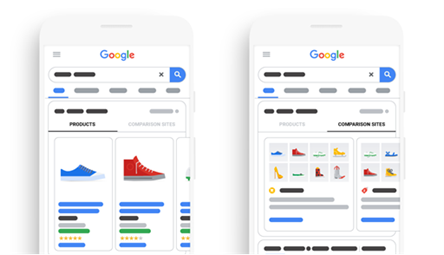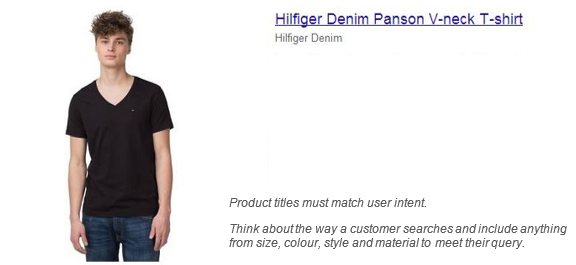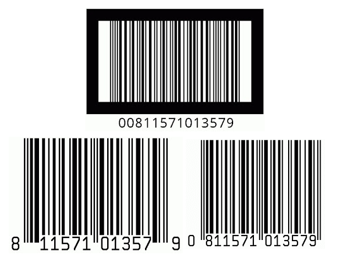Google recently announced the launch of Comparison Listing Ads (CLAs), a new shopping ad feature for Comparison Shopping Services (CSS).
In this article, we take a look at what this entirely new advertising format means for both Productcaster, our CSS partners and consumers.
What are Comparison Listing Ads?
Comparison Listing Ads allow CSS providers to advertise a group of products in the Google Shopping auction from the CSS website.
Designed to drive additional traffic to CSS providers, Comparison Listing Ads consist of images related to the user’s search, displaying a collection of similar or related products that are available on the respective CSS platform.

The CLA format will give consumers greater choice by being able to compare product prices across a number of retailers.
Where will CLAs appear?
An additional tab within the usual shopping results will indicate the presence of ‘comparison sites’. Consumers will be able to switch between both a product view and the new comparison site view.
The CLAs will appear in a second carousel for relevant searches, below the traditional Google Shopping carousel. The CLA carousel will show the user a collection of products available, allowing them to click through to view and compare on the CSS provider’s site.
However, it is worth noting that Comparison Listing Ads will only trigger when there are enough relevant ads available for a given query, currently understood to be three.
What does this mean for current Shopping results?
Comparison Listing Ads and their visibility is entirely separate to traditional Google Shopping results, and does not impact on the Shopping carousel served when a user makes a search.
The impact on the traffic available to those Shopping results as a result of consumers clicking through CLAs is not known at this stage as the ad format is still in beta. However, we will be working with our partners to understand this impact, and more so the wider opportunity that this new format presents.
Will CLAs be available on Productcaster?
Yes, Productcaster will offer CLAs.
As a Google Premium Partner, we were approached to be a part of the initial beta group and will be testing the new format prior to us launching it fully to ensure our approach really does add value both to our CSS partners and their customers.
To learn more about how you can benefit from CLAs and CSS, contact us today via email cssteam@productcaster.com or phone +44 (0)203 910 7026.
Are you a brand or agency who wants to learn how to save up to 75% on your feed management solution? Join us for our 45-minute webinar to find out how you can do exactly that.
Register for the webinar here.
The webinar will be hosted by Commercial Director of Productcaster, John Readman, and Managing Director of Marketing Technology for Summit, Dave Trolle.
Here’s what the webinar will cover:
The value of feed driven marketing
Feed driven marketing drives up to 60% of brand’s online revenue. Over recent years there has been exponential growth in channels which are primarily dependent on product feeds. We take a look at the opportunity for brands and agencies to better grow their feed driven marketing strategy.
How you can immediately profit from Feed Manager
Discover how to unlock the hidden value and gain insight into how you can profit from using a trusted feed management solution. This is an essential step that you must get right in order to maximise ROI on your feed driven marketing.
The simplicity and sophistication of our software as a service platform
Take a look at our Feed Manager solution including, publishing, optimisation, enrichment and diagnostics.
The success of brand and agencies using Productcaster
Listen to real-life case studies from brands and agencies and learn how using Productcaster has improved their online marketing strategy to drive success.
Interactive live Q&A
At the end of the webinar, you’ll be given the opportunity to learn, discuss and debate with like-minded peers and industry specialists.
Register for the webinar here.
In the meantime, why not sign up for your own FREE feed report to reveal missed opportunities, and improve the efficiency and revenue from your feed driven marketing.
Ensuring you keep your feed well optimised is one of the most important areas of your Shopping Campaigns. In fact, it’s key to their success. Making sure all the parts come together harmoniously to entice shoppers to click on your product will result in more revenue and engagement.
There are, however, there are numerous opportunities that agencies and brands miss when it comes to product feeds. In this article, we share our thoughts on what some of those opportunities are and how to make the most of them.
Poorly Structured Titles
Google has been kind enough to give a decent character count for your titles, so utilise it. It’s important to list any relevant product details as well as the brand, if the item is a branded product of course. The first 45 characters should include the most important attributes with the last 25 including other relevant information like product colour and size.
Titles should always be unique to the product you are marketing. If it’s a product variant, make sure you add something unique into the title to differentiate them from one another. Avoid keyword stuffing however and leave out block capital letters. Promotional text that discusses price and sale dates should be left out of your titles and added to the product descriptions.
In a nutshell, view your ads from the consumer’s perspective. If something isn’t obvious from the product image, then try to put this information at the beginning of your title so that it becomes obvious to your customers.

Short & Dull Product Descriptions
If you are selling a couch, should you call it a couch, a sofa or a settee? The right keywords are paramount in both your title and description. In this instance, sofa has a higher search volume than the other two, but that doesn’t mean you wouldn’t use those words elsewhere. Add sofa to the title and expand your reach by including settee and couch in the description.
On the subject of keywords, it’s important not to overwhelm your description by stuffing search terms in there. Try to make it sound as natural as possible while providing all the relevant information in engaging and attractive copy. You have up to 5,000 characters to play with, but users will need to click to expand a longer description, so it’s worth bearing that in mind.
Stock Availability Discrepancies
It is important to keep your availability information up to date. Imagine it from a consumer perspective: you see a stylish table lamp for sale at a great price and even better, it’s in stock.
Naturally, you click through to buy the product only to be told it’s out of stock. Not only is this frustrating but it reduces the chance of you buying from that brand again, and brand loyalty is especially important in the current retail climate.
Ensuring that the availability attribute in your product data matches that of your landing page will mean users shouldn’t try to buy a product that you don’t have in stock.
Pricing Issues
A common oversight brands and agencies often make is relying on a site scrape alone to update their pricing. Although not an issue if the site is relevant and up to date, challenges may arise if the site does not align with promotions and frequent pricing changes.
A more reliable process would include a feed management solution which accounts for numerous price changes per day. This is particularly important for retailers who change promotions or are in sales.
Missing/Incorrect Unique Product Identifiers
Unique product identifiers do pretty much what they say on the tin. They define the product that you are selling within the global marketplace. Common examples of UPIs include Global Trade Item Numbers (GTINs), Manufacturer Part Numbers (MPNs) and brand names.

The purpose of including UPIs is to simply make your ads richer and easier for users to find. When it comes to GTINs however, not all products have one assigned, meaning there is no need to submit one. It’s important though that if an item does have a GTIN, it is submitted as the product could be disapproved if you don’t. Some examples of products that may not have an assigned GTIN include:
- Store-brand products
- Replacement parts
- Vintage or antique products
It’s important to note that the GTIN/EAN number must be valid and match what is in Google’s own database. If the number isn’t valid, it will be flagged by Google in the Merchant Centre.
Those are just a few of the opportunities that agencies and brands can miss in their product feeds. If you’d like to find out more about how Productcaster can help you unlock the hidden value in your feed and beyond, get in touch with the team today by calling +44 (0)203 910 7026 or email cssteam@productcaster.com
Google announced back in December 2018, changes to the criteria to the minimum requirements as a Google Comparison-Shopping Services (CSS) partner. The purpose of this was to raise the bar to becoming a partner, enhancing the customer experience on the partner comparison sites. This included the following requirements:
- A Google CSS partner needs 100 merchants
- A premium CSS partner needs 500 merchants
- All partners need 50 merchants per country where shopping offers are displayed
From today, February 21st 2019, Google will enforce these requirements across all partners. The number of official CSS partners on the Google CSS partner finder page has dropped from over 130 to just 48 across Europe - we are pleased to say we remain an official partner.
What this means for retailers?
If you already have an existing CSS and they are no longer eligible to advertise in your territories, all ads for those countries will be disapproved. Some may have been aware since earlier this month, an ongoing red alert flag in the Merchant Center, highlighted as a warning, will now become error messages if no action is taken. Explore what your current CSS partners strategy is and how they plan to adhere to the most recent Google update. As a fully compliant partner across EU markets, we are here to support you if you are not happy with the answers to your questions.
What this means for partners?
For those CSS who are eligible with the merchant count of 50 territories, service remains unchanged. In the instance where this threshold is not met, we have options to enable CSS partners to provide continuous service and support for their existing clients whilst remaining a valuable service for their own agency.
These include:
- White label platform: licence our platform and apply this to your existing CSS brand
- Productcaster partner: migrate your existing and future clients to Productcaster and become an official Productcaster reseller
The benefits of the Productcaster platform
As early adopters of the CSS initiative, our continued service and support to the development of the Productcaster platform enables us to offer the following benefits for our clients:
Product integration:
- Integrate your merchants at pace through our Google Merchant Center synchroniser
- An infinite number of products published daily
- Compatible to integrate with Marketplace merchants, with high volumes of accounts
User experience:
- Multi-product filtering to increase product discoverability for users
- Lowest bounce rates in the market
- High-performance site, with average page load speeds at or below industry benchmarks
Technical infrastructure:
- The highest level of site security (A+)
- High-performance, full-featured text search engine
- Image optimisation and improved security for merchants that don’t support HTTPS for images
- Content delivery network to ensure speed in all countries
Our goal into 2019 and beyond is to ensure retailers and agencies have continued support and service. If you would like to find out more about how we can work together, contact a member of our CSS team on cssteam@productcaster.com or call +44 (0)203 910 7026


